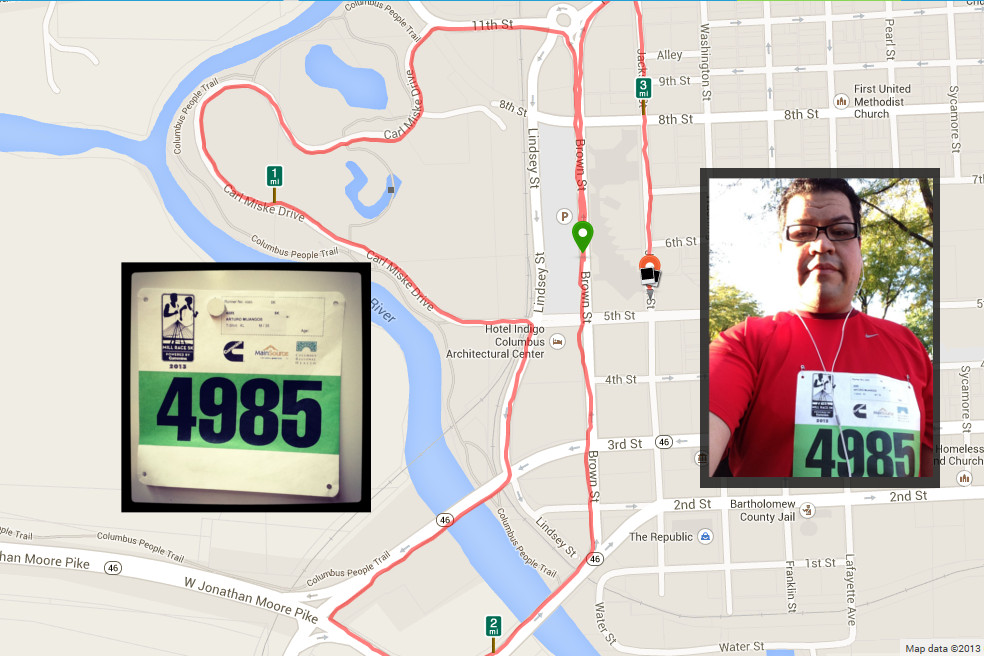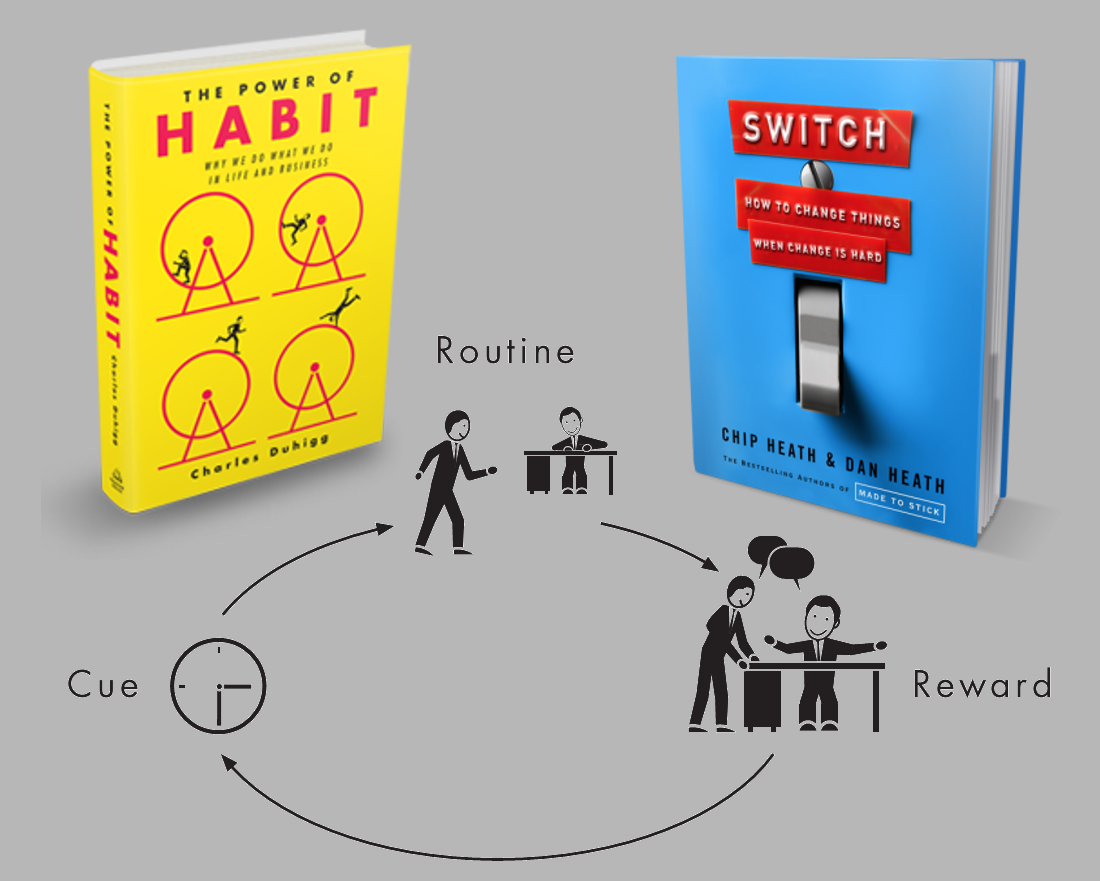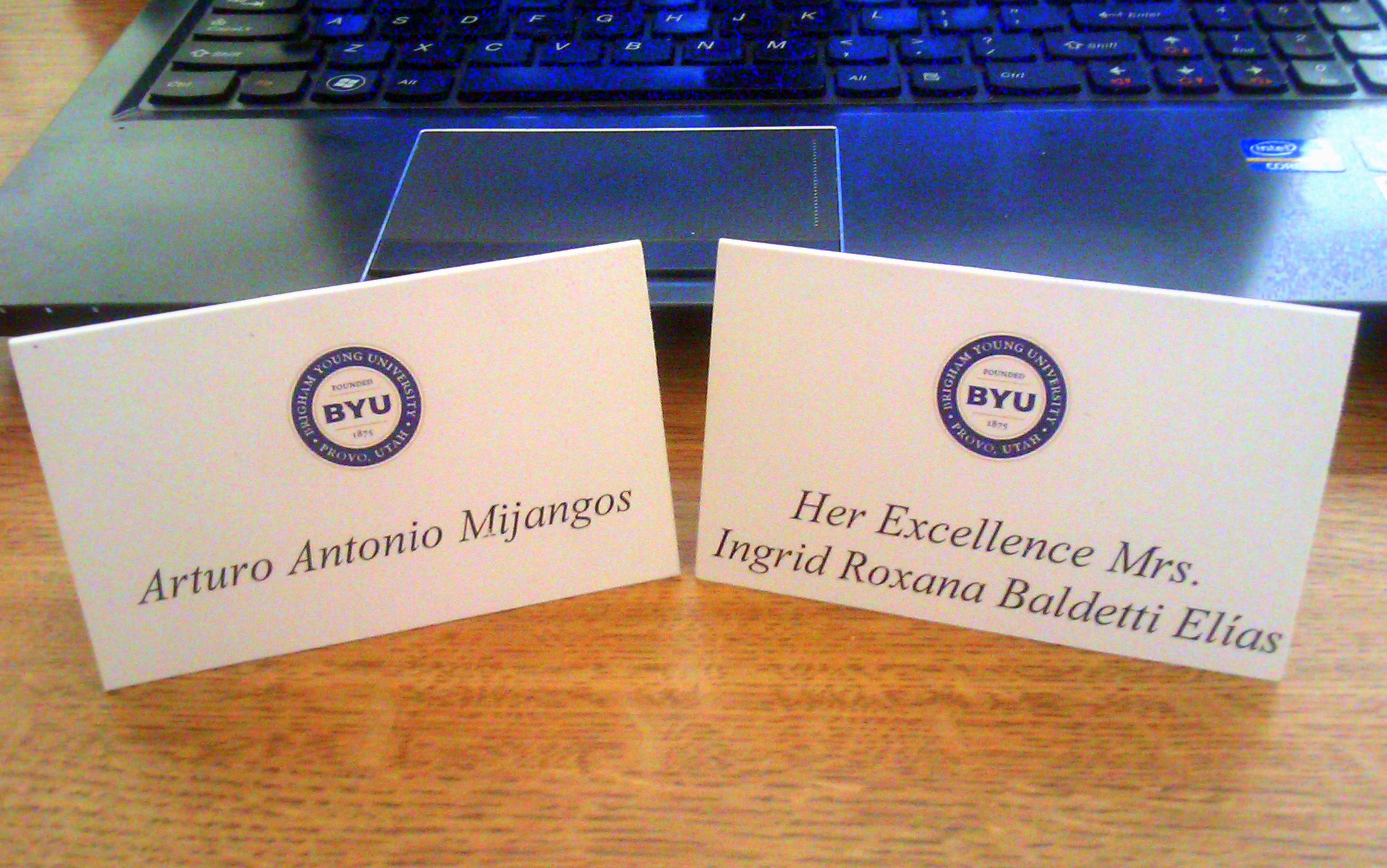 A week ago I had the chance of participating in the Columbus Mill Race 5K. Although to many that might seem like an insignificant acomplishment, it was the first part of my journey. A few months back I laid a plan for me to get there. It had been almost 10 years since my last organized race, and this is only my second experience.
A week ago I had the chance of participating in the Columbus Mill Race 5K. Although to many that might seem like an insignificant acomplishment, it was the first part of my journey. A few months back I laid a plan for me to get there. It had been almost 10 years since my last organized race, and this is only my second experience.
So you want to write a Blog
So I’m sure there are a lot of sites that can help you create a blog, what I want to detail here is for you to have a blog like this one. So it’ll be more of an introspection than a how to, but hopefully at the end you’ll say “YES, I can do this.”
Continue reading “So you want to write a Blog”
Thanks for listening Dockers.com

Dear Dockers.com
 Today I wanted to purchase these pants on your website, but alas you don’t have my size. It is true you probably created some algorithm that told you that this style might not appeal to certain waist/length combination, and I get that. My problem is that there is no way to let you know that there is one customer that wants it, mas the motivation to buy it, and the ability to do so. Your algorithm has no feedback, and unless you fix that it will never do.
Today I wanted to purchase these pants on your website, but alas you don’t have my size. It is true you probably created some algorithm that told you that this style might not appeal to certain waist/length combination, and I get that. My problem is that there is no way to let you know that there is one customer that wants it, mas the motivation to buy it, and the ability to do so. Your algorithm has no feedback, and unless you fix that it will never do.
So please, if you read this, adjust your algorithm so that on your next round you save one W40 x L30 Alpha Khaki Riviera pants for me.
Thanks
Arturo
Multinational teams – Are they doomed from the start?
Jeane Brett in her book, Negotiating Globally, writes the following:
Teams bring essential resources to big, complex tasks. Teams can produce creative ideas, meet deadlines with quality products, and negotiate decisions that generate corporate growth and prosperity. Research shows that when team minorities dissent, majorities are more likely to generate original and novel solutions to problems. Organizations grow faster when top-management teams engage in constructive debate. Companies with top-management teams that engage in debate have a higher return on investment. Cross-functional, new-product teams are more innovative when they have a lot of disagreement about task design if they have a norm for open expression of doubts or if they engage in collaborative problem solving. Constructive controversy, the open-minded discussion of opposing views for mutual benefit, appears to be the key to creating value during multicultural team decision making.”
As I’ve spent last year and this year working with groups that come from different backgrounds and different countries I can see the value in multicultural, multinational teams. Continue reading “Multinational teams – Are they doomed from the start?”
Learning About Habits
UPDATE (6/3/2013) – It has been 2 weeks that i have started, and I feel great. I’ve added a new short term destination which is a 5K run in Sept.
The last 3 weeks I’ve been reading about habits and change, now that I’m graduating from graduate school and starting a new job I wanted to start creating better habits. I want better habits for exercise, healthy eating, and spiritual development. I chose 2 books, because the reviews were good and I had seen them in different places and recommended by different people.
 The Power of Habit: Why We Do What We Do in Life and Business by Charles Duhigg My rating: 3 of 5 stars |
 Switch: How to Change Things When Change Is Hard by Chip Heath My rating: 4 of 5 stars |
| The book is powerful in explaining the why of habits. The author offers great stories and studies on habits. While reading the book, I felt that I wasn’t getting a good framework for creating new habits or changing bad one. There are stories about both topics, but nothing was really concrete. At the end of the book, the author revisits all the topics and creates a framework for establishing new habits or changing old ones; but it seems like an after thought. | Great book, it does a great job of setting a road map that is easy to follow when determining change. The process is simple and straightforward. The book is set up in a way that the reader can find the information that they need in order to implement change. The book doesn’t go too deep into the theory, but rather points to practices that maybe implemented in order for change to happen. Each part of the book works independent, but for big changes to happen all pieces need to intertwine one with another. I truly like this book. |
I want to show some highlights from both books, and then for my sake create a plan for my morning routine that I want to start.
The Basics
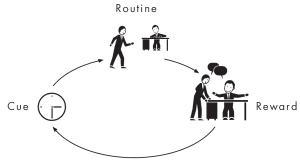
All habits have 3 parts to them, the Cue, the Routine and the Reward. The 2 most important parts are the cue and the reward. To change a habit you need to identify what is the cue, and what is the reward, and then change the routine that goes in the middle. For new habits you need to create a cue that will trigger the routine that you want to implement and a reward for doing it. Here is a link to 2 documents that diagram this very well: [UPDATE (09/10/2019) links are broken from the author’s site]
- For new habits see: How to make a habit
- To change an old habit: How to break a habit
Making Deeper Changes
The framework from Switch is easy to understand and follow. Here are the basics:
- DIRECT the Rider
- FOLLOW THE BRIGHT SPOTS. Investigate what’s working and clone it. [Jerry
Sternin in Vietnam, solutions-focused therapy] - SCRIPT THE CRITICAL MOVES. Don’t think big picture, think in terms of specific
behaviors. [1% milk, four rules at the Brazilian railroad] - POINT TO THE DESTINATION. Change is easier when you know where you’re
going and why it’s worth it. [“You’ll be third graders soon,” “No dry holes” at BP]
- FOLLOW THE BRIGHT SPOTS. Investigate what’s working and clone it. [Jerry
- MOTIVATE the Elephant
- FIND THE FEELING. Knowing something isn’t enough to cause change. Make
people feel something. [Piling gloves on the table, the chemotherapy video game,
Robyn Waters’s demos at Target] - SHRINK THE CHANGE. Break down the change until it no longer spooks the Elephant. [The 5-Minute Room Rescue, procurement reform]
- GROW YOUR PEOPLE. Cultivate a sense of identity and instill the growth mind-set. [Brasilata’s “inventors,” junior-high math kids’ turnaround]
- FIND THE FEELING. Knowing something isn’t enough to cause change. Make
- SHAPE the Path
- TWEAK THE ENVIRONMENT. When the situation changes, the behavior
changes. So change the situation. [Throwing out the phone system at Rackspace,
1-Click ordering, simplifying the online time sheet] - BUILD HABITS. When behavior is habitual, it’s “free”—it doesn’t tax the Rider.
Look for ways to encourage habits. [Setting “action triggers,” eating two bowls of
soup while dieting, using checklists] - RALLY THE HERD. Behavior is contagious. Help it spread. [“Fataki” in Tanzania,
“free spaces” in hospitals, seeding the tip jar]
- TWEAK THE ENVIRONMENT. When the situation changes, the behavior
My New Habit
My new habit for my morning routine: (I will update my progress)
- For the elephant:
- The feeling: A picture of my Dad by the alarm clock, reminding me what I want to avoid.
- The identity: I am a runner
- For the rider:
- Critical moves: Up by 6:00am, Scriptures by 6:20am, Gym by 6:30, off to work by 7:30am
- Destination:
- 5K Run – Mill Race Marathon, Columbus Indiana
- 1/2 marathon in a year, my buddy does vacation races and they look great.
- For the path:
- Tweak the environment: Pack the gym bag at night, just put on shoes and go
- Build a habit: Habit loop (from The Power of Habits)
- Cue: Alarm 6:00am
- Routine: Up by 6:00am, Scriptures by 6:20am, Gym by 6:30, off to work by 7:30am
- Reward: Buy lunch, otherwise shake for lunch
- Rally the herd: Find a gym buddy
Multipliers: How the Best Leaders Make Everyone Smarter
 Multipliers: How the Best Leaders Make Everyone Smarter
Multipliers: How the Best Leaders Make Everyone Smarter

Wonderful book about becoming better by helping those around us excel. Liz Wiseman wrote an article in the blog from Harvard Business Review and I was hooked. You can find the article about Smart Leaders here: http://blogs.hbr.org/cs/2012/08/smart_leaders_get_more_out_of.html I tried to sumarize, mainly so that I don't forget the key points down below. You can find more information in The Wiseman Group website.
Traits of Multipliers
- Talent Magnet
- Liberator
- Debate Maker
- Challenger
- Investor
Talent Magnet
The Four Practices of the Talent Magnet
- Look for Talent Everywhere
- Appreciate all types of genius
- Ignore boundaries
- Find People’s Native Genius
- Look for what is native
- Label it
- Utilize People to Their Fullest
- Connect people with opportunities
- Shine a spotlight
- Remove the Blockers
- Get rid of prima donnas
- Get out of the way
Becoming a Talent Magnet
- Become a genius watcher
- Pull some weeds
Liberator
The Three Practices of the Liberator
- Create Space
- Release others by restraining yourself
- Shift the ratio of listening to talking
- Operate consistently
- Level the playing field
- Demand Best Work
- Defend the standard
- Distinguish best work from outcomes
- Generate Rapid Learning Cycles
- Admit and share mistakes
- Insist on learning from mistakes
Becoming a Liberator
- Play your chips
- Label your opinions
- Make your mistakes known
Challenger
The Three Practices of the Challenger
- Seed the Opportunity
- Show the need
- Challenge the assumptions
- Reframe problems
- Create a starting point
- Lay Down a Challenge
- Extend a concrete challenge
- Ask the hard questions
- Let others fill in the blanks
- Generate Belief in What Is Possible
- Helicopter down
- Lay out a path
- Co-create the plan
- Orchestrate an early win
Becoming a Challenger
- Ask a leading question
- Take a bus trip
- Take a massive baby step
Debate Maker
The Three Practices of the Debate Maker
- Frame the Issue
- Define the question
- Form the team
- Assemble the data
- Frame the decision
- Spark the Debate
- Create safety for best thinking
- Demand rigor
- Drive a Sound Decision
- Reclarify the decision-making process
- Make the decision
- Communicate the decision and rationale
Becoming a Debate Maker
- Ask the hard question
- Ask for the data
- Ask each person
Investor
The Three Practices of the Investor
- Define Ownership
- Name the lead
- Give ownership for the end goal
- Stretch the role
- Invest Resources
- Teach and coach
- Provide backup
- Hold People Accountable
- Give it back
- Expect complete work
- Respect natural consequences
- Make the scoreboard visible
Becoming an Investor
- Let them know who is boss
- Let nature take its course
- Ask for the F-I-X
- Hand back the pen
IF
If you can keep your head when all about you
Are losing theirs and blaming it on you,
If you can trust yourself when all men doubt you
But make allowance for their doubting too,
If you can wait and not be tired by waiting,
Or being lied about, don’t deal in lies,
Or being hated, don’t give way to hating,
And yet don’t look too good, nor talk too wise:
If you can dream–and not make dreams your master,
If you can think–and not make thoughts your aim;
If you can meet with Triumph and Disaster
And treat those two impostors just the same;
If you can bear to hear the truth you’ve spoken
Twisted by knaves to make a trap for fools,
Or watch the things you gave your life to, broken,
And stoop and build ‘em up with worn-out tools:
If you can make one heap of all your winnings
And risk it all on one turn of pitch-and-toss,
And lose, and start again at your beginnings
And never breath a word about your loss;
If you can force your heart and nerve and sinew
To serve your turn long after they are gone,
And so hold on when there is nothing in you
Except the Will which says to them: “Hold on!”
If you can talk with crowds and keep your virtue,
Or walk with kings–nor lose the common touch,
If neither foes nor loving friends can hurt you;
If all men count with you, but none too much,
If you can fill the unforgiving minute
With sixty seconds’ worth of distance run,
Yours is the Earth and everything that’s in it,
And–which is more–you’ll be a Man, my son!
–Rudyard Kipling
Vicepresidenta Roxana Baldetti en BYU
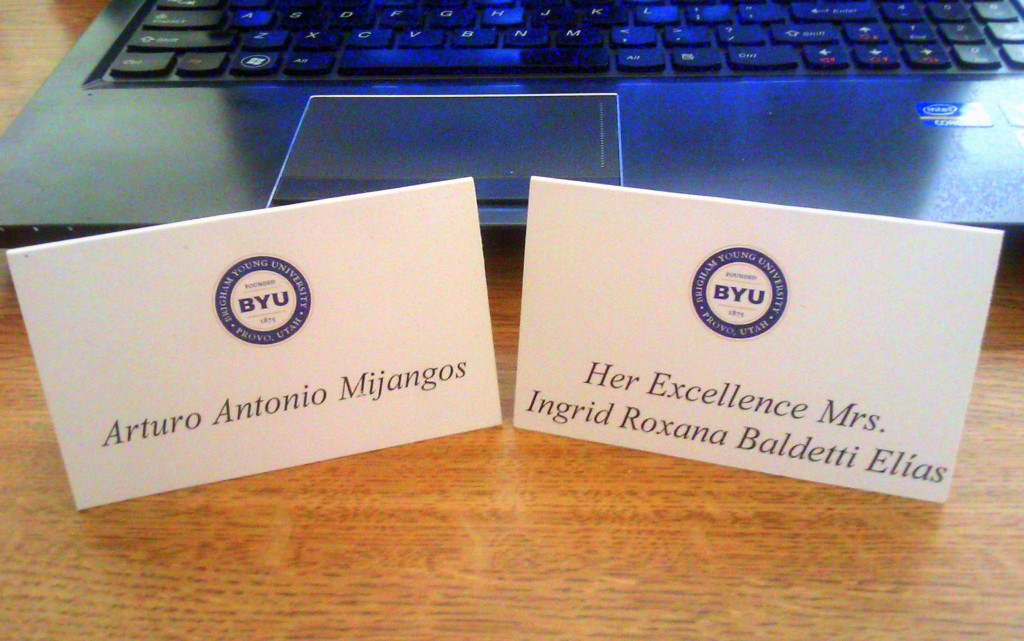
Por algun tiempo he tenido las ganas de escribir en español y contar sobre la visita de la visepresidenta Roxana Baldetti a BYU. El 31 de agosto recibi un correo de oficina de asuntos internacionales de la universidad que decía:
Her Excellency Mrs. Ingrid Roxana Baldetti Elias, Vice President of Guatemala, will visit Utah next week. We have the honor of hosting her at BYU on Tuesday, September 4. We have room at the luncheon for a few students. We would like to invite you to the luncheon honoring her at 12:45 p.m. in the President’s Dining Room, 3264 WSC.
En corto, que iba a tener el privilegio de participar en este almuerzo con el presidente de la universidad, aunque al final no fue el presidente sino el vicepresidente. Acepté la invitación y estaba muy emocionado.
El día del evento todo estuvo muy bien, tuve el placer de conocer a la visepresidenta, el almuerzo estuvo delicioso. Los platillos ya los habia comido antes en otros eventos de la universidad, pero les hicieron cambios para congraciar a los representates de Guatemala. El postre que normalmente lo hacen con crema, lo hicieron con una compota de banano y les quedó muy sabroso. La ensalada la sirvieron con platalinas en lugar de papalinas, tambien un toque muy sabroso. Hubo un número especial por el grupo de baile “Living Legends” donde mostran bailes de los indios americanos, mi favorito es el baile de los aros. Realmente fue un bonito festival de arte y cultura.
Al concluir con la comida y el número especial la visepresidenta nos dejó con algunas palabras traducidas por el Elder Carlos H. Amado, donde nos dijo lo mucho que habia apreciado la ayuda que la Iglesia de Jesucristo de los Santos de los Ultimos Días habia brindado al pueblo de Guatemala. Ella habia aprendido la forma en que los Mormones cuidan de los probres y necesitados y esperaba ella, como responsable de los projectos sociales de Guatemala, poder ayudar a los más necesitados salir de la probreza.
Hace unos días el Presidente de Guatemala recibió a un miembro de los 12 apóstoles y recordaron la visita de la visepresidenta en BYU. Hay veces que vemos noticias y nos damos cuenta que en una pequeña manera fuimos parte de importantes eventos. Realmente estoy muy agradecido de poder estar en esta universidad, pero tambien de ser Guatemalteco.
International Marketing

This semester I’m taking a class called “International Marketing.” It is a requirement so that I can graduate with a certificate in Global Management. The course feels very open and flexible, and the professor seems to be taking a more open approach to the course itself. So this got me thinking about, what should a course in International Marketing have. For me, these would be the learning outcomes:
- Effectively create marketing strategy decisions that will consider the global landscape
- Provide arguments for and against marketing decisions that cross borders
- Build a framework by which to measure risk of cross border marketing plans
- Have knowledge of how to structure global teams and how to measure them
Wikipedia defines International Marketing as:
International marketing (IM) or global marketing refers to marketing carried out by companies overseas or across national borderlines. This strategy uses an extension of the techniques used in the home country of a firm. It refers to the firm-level marketing practices across the border including market identification and targeting, entry mode selection, marketing mix, and strategic decisions to compete in international markets. According to the American Marketing Association (AMA) “international marketing is the multinational process of planning and executing the conception, pricing, promotion and distribution of ideas, goods, and services to create exchanges that satisfy individual and organizational objectives.” In contrast to the definition of marketing only the word multinational has been added. In simple words international marketing is the application of marketing principles to across national boundaries.
So in essence you 2 things, (1) knowledge of your home country and (2) knowledge of the foreign country. I have worked and traveled in several countries, and just knowing a different country and culture does help you understand the intricacies of a country and allows you to compare and contrast things that will and will not work. Knowing a second language multiplies that knowledge. In my case, I speak Spanish and English, and have worked in 8 countries and traveled to others, but I want to learn a way to translate this knowledge into a framework to understand other cultures and markets. I think that the short answer I will find this semester is no, there is no framework.
A similar discipline to marketing is that of negotiation, in a way marketing is a negotiation, some very active like a rep visiting a client overseas, but mostly passive, like a commercial or a logo. In the book “Negotiating Globally” the author Jeanne Brett goes deep into culture as the basis for thinking globally. She compares culture to an iceberg and structures 3 distinct layers, the first being the only one we can see (p. 28). Here are the layers:
- Behaviors and institutions
- Knowledge structures: Values, beliefs, and norms
- Fundamental assumptions
I want to have a framework that takes a marketing strategy and is able to break it down into:
- Which behaviors and institutions does this plan relay on
- What are the core values, beliefs and norms? Are they the same in all targets? How should we account for the differences?
- Lastly, Is our product/service/offering go against any fundamental assumption?
In thinking about his, I think on the examples of products that are launched in markets that have no need for them. Or just lost in translation blunders (here are some)There was probably some executive that said: “we’ll create the demand.” There are other products that would seem no need for them, or have had poor reception in other markets and seem all the craze in others. Is there a way to x-ray the marketing plan in order to extract this knowledge?
I really want to find a way, maybe I will this semester or maybe I’ll just read old cases that shed no light on the subject. As always, the burden is on me to come up with the learning I want.

